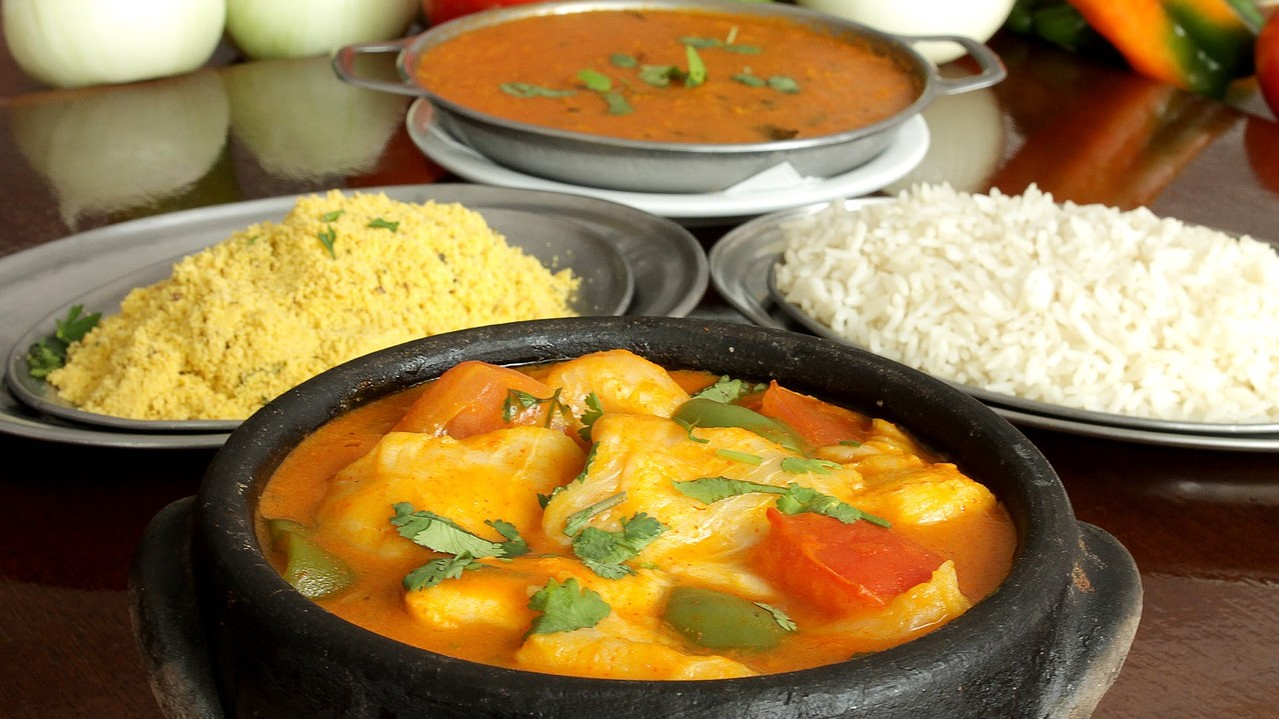Moqueca, Brazilian Seafood Stew, Is Bahia In A Bowl
I remember the hesitation I felt when I landed in Rio and started to sample Brazilian food. I love everything about Brazil, the effervescent spirit of the people, the music, the traditions. So I had thought it would be a given that I would also love the cuisine, typically served in heaping portions with an assortment of sauces and toppings like farofa, or toasted manioc flour, all of which were unfamiliar to me. Food was everywhere in Rio: the air was filled with the salty and spicy aromas of street vendors selling pao de queijo (cheese bread balls made with cassava flour), coxinha (chicken croquettes), and aipim frito (fried cassava chips).
But when I sat down for my first meal, I was dismayed to discover just how many of Brazil's popular dishes feature meat. First, there was the national dish, feijoada. This hearty black bean stew includes not only sausage, but practically every piece of the pig except the oink. Then there was picadiho, which directly translates as meat stew. There were also various filets, skewered and barbecued meats served in eye-popping quantities. Brazilians, like most South Americans, love their meat. I, unfortunately, do not. I have not eaten meat (or even been tempted to) in over 20 years. I'm not vegan or even vegetarian; I eat fish and poultry, just not red meat. So I was a little afraid of how limited my culinary options would be during my stay. I liked the codfish cakes called bolinho de bacalau and coxinhas, but these are appetizers and snacks. I suppose I could have ordered grilled chicken, although I didn't see it on any menu, and ordering off-menu felt like the wrong move. Besides, who wants to eat grilled chicken in cidade maravihosa? I wanted a dish that showcased the flavors of Brazilian culture. So what was I going to eat for the next two weeks?
After passing up dozens of meat-studded dishes in Rio, I had resigned myself to nibbling on (excellent) street and bar snacks like pastels, savory pastries stuffed with chicken, cheese, beef, or cod. Since it was winter, I couldn't even try the city's legendary beach food scene. (Make no mistake, Cariocas are on the beach all year round, but the experience is more subdued.) Then I flew to the northeastern city of Salvador da Bahia.

The state of Bahia cradles the shores of the Atlantic ocean and unfolds with candy-colored colonial architecture. Bahia is considered the heart of Brazil: when you think of the nation's culture—the music and dance of samba, the dance/martial arts form capoeira, the syncretic religion of Candomblé—this is where you'll find it. Bahian food sits at the top of this pile of cultural riches. In the cobblestone streets of Salvador, the capital city, Baianas, women decked in traditional flowing white dresses and headwraps, serve up acarajé, a black-eyed pea fritter fried in dende (palm oil). The dish is so significant that it has been declared an intangible national treasure.
It was while I was munching acarajé (which is usually topped with an okra stew called caruru and vatapa, a dried shrimp and cashew mixture) that a smiling Baiana advised me to try moqueca. When I asked her what it was, she explained it was an important Bahian dish flavored with coconut. I love anything with coconut, so I headed to the nearest restaurant to try it. Luckily, the beachfront restaurant I chose, Restaurant Yemanjá, specializes in moqueca. Although the basic ingredients for the fish stew are white fish, coconut milk, tomatoes, bell peppers, and the all-important dende oil, Yemanjá featured a dozen variants: octopus, soft shell crab, oyster, even stingray.
According to Georgina Pereira, Brazilian chef and owner of Chicago's Sinhá Brazilian restaurant, moqueca ingredients can be adjusted according to preference. "Usually it's made with fish and sometimes shrimp, but you can use other shellfish or even make it vegetarian," she says. The base, however, remains the same: "I always use coconut milk, tomatoes, green peppers, garlic, and dende oil. There is no Bahian food without dende oil."
Moqueca represents Brazil's mix of African, indigenous, and Portuguese cultures. Dating back 400 years, the name moqueca is derived from the Tupi name, moquem, which refers to fish or vegetables wrapped in leaves and roasted over a fire. The dish evolved into one that was cooked in a clay pot when enslaved Africans added dende oil and coconut milk to the Portuguese colonialist's fishing tradition.
When the bowl of moqueca was set in front of me, the scent of coconut and spices floated up from the white stew tinged with yellow from the oil. The creamy texture was soothing, the flavors rich and earthy, finishing with the bright tomatoes. I feasted on moqueca throughout the rest of my stay in Brazil. This simple stew is all the flavors of the country in one bowl—well, except pork. I had discovered the Brazilian dish for me, and I scooped it up over rice and ate every morsel.
